Varietal variety of herbaceous peonies
Purple peonies (photo presented below), although they are rare, are found almost among representatives of all varieties of this plant.
Herbaceous species are represented by the following varieties of the presented type:
- Bowl of Beauty. The shape of the inflorescence, reaching a diameter of 20 cm, is Japanese. Blooms with lilac-pink buds. In the center, the petals are painted in a light yellow tint.
- Anastasia. Terry variety, the inflorescences of which look luxurious against the background of green foliage. This peony blooms late, so it is more suitable for warm regions. The bud has a pink-lilac hue. The petals are colored at the ends in a light gray shade. The length of the leg on which the bud opens reaches 90 cm.
- Alexandr Duma. It is a herbaceous purple bomb-shaped peony. The inflorescences are painted in a bright, rich pink-lilac color. The petals are up to 13 cm long. This is an old variety that was bred back in the 19th century. It was cultivated in France. The peony blooms late and gives off a strong sweet scent during this period.
- Bellville. A late-flowering variety that emits a faint pleasant aroma during the budding process. The shape of the inflorescences is anemic. The petals are painted in a lilac-purple light tone.
- Purple Ocean. The buds are crown-shaped and have a lilac hue. The variety is frost-resistant, can bloom up to 3 weeks. During flowering, inflorescences up to 16 cm in diameter emit an incredibly pleasant aroma.
- Monsieur Jules Em. It is an early variety that has more than a century of history. Inflorescences are of the terry bomb-shaped type. The petals are painted in lilac-pink light shades. The aroma of the buds, up to 20 cm in diameter, is strong and very pleasant.
- Black Crown. These are probably the most purple peonies of all herbaceous varieties. The petals of the buds, which are 17 cm in diameter, are shiny, painted in a dark purple hue. The variety is frost-resistant, well cultivated in temperate climates. If the region is cold, you need to cover the plant for the winter.
- Sarah Bernhardt. This is an early variety known in our country. The shade ranges from lilac to pink. The petals are large, reaching 16 cm in span. The buds stand out effectively against the background of dark leaves.
- Imperial Crown. The inflorescences are very large, reaching 25 cm in diameter. They are spherical. They bloom for about 2 weeks or even longer depending on weather conditions.
Features of planting and care
Garden peonies are quite unpretentious. They do not cause much trouble if they are fed and monitored on time.
First you need to choose a landing site. You need to do this carefully, since the plant will grow on it for at least ten years. The site for the plant should be chosen on the sunny side so that there is enough light for 4-5 hours per day. The plant should be protected from drafts so that there is a fence, hedge or other shrubs nearby. It is necessary to beware of planting in the lowlands so that the roots do not rot.
Garden peonies are quite unpretentious
Experts advise planting in the fall. At this time, the stems and the root system go into a dormant state and will tolerate planting more easily. In the spring, the rehabilitation period will be longer. If the division has already been prepared, then planting the plant in open ground is carried out in several stages:
- It is necessary to excavate a cone-shaped hole 60 cm deep.
- Prepare a drainage layer.
- Form a nutrient layer. Composition: a mixture of compost, 100 g of dolomite flour, 200 g of superphosphate, 300 g of ash and 70 g of potassium sulfate.
- Add soil in such a way that 15 cm remains to the bottom of the pit.
- It is necessary to place the seedling in the hole, correct the protruding root.
- Place the lower bud on the stem 5 cm below the ground.
- Cover the roots with soil, compacting the earth.
- Water abundantly.
Important! You cannot change the planting site of the peony for another 3-4 years until the plant recovers. Young seedlings must be covered with sawdust with a layer of 10 cm for the winter.
Care consists in proper watering, feeding and pruning. It is imperative to cut off dead leaves and stems so that they do not lead to the development of diseases. Watering is necessary rarely, but abundantly. About 2-3 buckets per adult plant.
Care consists in proper watering, feeding and pruning
The shrub should be watered at the root, not on the leaves. Leaves may turn yellow.
What are the types of peonies
Regardless of the color of the petals, and it varies from snow-white to deep burgundy, all peonies are divided into 5 groups:
- The first group includes non-double flower varieties with no more than 10 petals. They are arranged in one or two rows, and in the middle there are pistils surrounded by stamens. A characteristic feature of the group is straight and strong stems.
- The next group is anemone peonies. Usually there are 5 petals in the bud, but there may be more, they are located in 2 or 3 rows. The stamens of these flowers are modified, they completely fill the middle of the bud.
- Japanese peonies are a transitional type from a simple flower to a double flower. The modified stamens are petal-shaped, in some cases they are bent downward, thus forming a pillow. The shade of the stamens is contrasting with respect to the petals or the same (pink, yellow, red).
- Semi-double varieties are characterized by five or more petals. Their stamens are modified, normally developed and petal-shaped. Arranged in a ring, they alternate with each other. A characteristic feature of all varieties of this group is a long-lasting fresh look when cut.
- The flowers of the terry group have more than 5 petals, they are quite wide. In most double varieties, the stamens are modified into petals, however, there are varieties with normally developed pistils and stamens, hidden petals.
Another classification is carried out according to the flowering time of peonies: early, mid-early, medium, mid-late, late, very late.
Varieties with pink flowers
Among the old French varieties, there are many varieties with pink flowers. And the most famous of these is, of course, ‘Sarah Bernhardt’, a strain bred by Lemoine in 1906 and named after an outstanding French dramatic actress.
Unsurpassed ‘Sarah Bernhardt’ (‘Sarah Bernhard’) Photo by the author
Talking about the beauty and exceptional economic qualities of this variety has already become common. And indeed: of fantastic beauty, the densely doubled caps of flowers of some amazing pink-lilac shade of blackcurrant sorbet of a perfect pink shape. Harmonious bush and abundant flowering make this variety the most famous and desirable in our gardens. Among its advantages are strong stems, rare vitality, delicate aroma.
Dense double caps of flowers of an amazing pink-lilac shade. Variety 'Sarah Bernhardt'. Photo by the author
There are many more masterpieces in the line of French pink peonies. This is a pink-lilac blooming profusely ‘Albert Crousse’ (‘Albert Kruss’, 1893); similar to him, only with silvery tips of the petals, and still popular multiple winner of exhibitions in the nomination "People's Choice Award" ‘Monsieur Jules Elie’ (‘Monsieur Jules Elie’, 1888).
‘Albert Crousse’ (‘Albert Crousse’), pink-lilac blooming. Photo by the author
Or fragrant 'Alice Harding' ('Alice Harding', 1922) with dark pink outer petals and a creamy white crown, as well as light pink 'Belle Douaisienne' ('Belle Doisier', 1861) and 'Madelon '(' Madelon ', 1922) with light pink outer petals, creamy pink crown and red marks.
Fragrant 'Alice Harding'. Photo from paeo.de
Collectors can still find the extremely rare now pink ‘Eugenie Verdier’ (‘Eugenie Verdier’, 1864) - crown, with pink outer petals and a light pink center of narrow petals, with yellow saturation inside.
Courtly Frenchmen loved to devote their creations to ladies, among the French peonies there are many. These are pink varieties of different shades:
- ‘Madame Boulanger’ (‘Madame Boulanger’, 1886) is a rosy variety with silvery flesh-edged petals;
- ‘Madame Calot’ (‘Madame Calot’, 1856) is a hemispherical peony with pink lower petals and cream central ones;
- ‘Madame Marine’ (‘Madame Marine’, 1881) a rare salmon pink shade;
- ‘Madame Reignoux’ (‘Madame Renue’, 1909) with pink-red flowers.
‘Madame Calot’ (‘Madame Calot’) is a hemispherical peony.
Of the first peonies obtained in France in the middle of the nineteenth century, the crown ‘Philomele’ (‘Philomel’, 1861) is not uncommon. It is a cultivar with lilac-pink outer petals, a creamy crown, and a lilac-pink center, sometimes with red markings. Don't you recognize? After all, this is a description of a peony, which can very often be found in our gardens, without realizing that this is a rare historical variety, and we take it for an ordinary one!
The old variety 'Philomele' ('Philomel').
Pink flowers
Among the peonies with pink petals, representatives of all groups are found. The most popular ones are:
- Solange. This spectacular variety was bred by French breeders a century ago. The bud does not exceed 18 cm in diameter, and the petals are pastel cream and pale pink in color. It is possible to grow this variety of peonies in almost any region, since the plant is resistant to the vagaries of the weather and has a high immunity.
- Ballerina. One of the representatives of the early flowering group, the first buds bloom in the last days of May. Ballerina was bred by a breeder from America. The diameter of the flower varies between 14-16 cm, and the height of the bush does not exceed 80 cm. In the first days of flowering, the terry petals have a creamy tone with a greenish tint, and then become snow-white.
- Madame Butterfly. The variety belongs to the Japanese group with an average flowering period. The diameter of the bud with crimson-pink petals is within 15-16 cm. The height of the perennial bush does not exceed 100 cm. Its stems are strong and have a curved shape. For cultivation, it needs a well-lit area, in extreme cases, a small partial shade is suitable.

Low-growing varieties of lilac
Meyer's lilac Tinkerbell
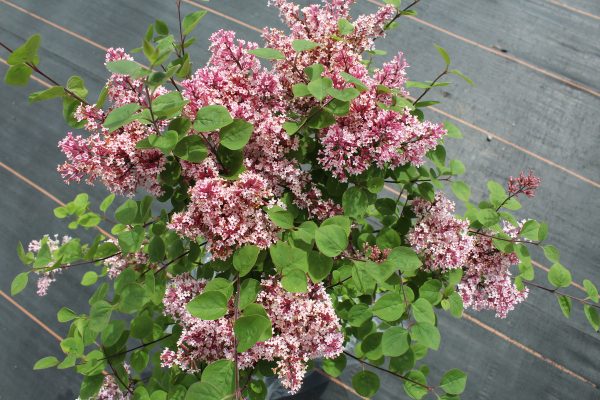
Meyer's lilac Tinkerbell
- A dwarf variety of lilacs with a height and diameter of up to 1.5 m.
- The buds are painted in a bright cherry hue. The flowers are delicate pink, small (0.5-0.6 cm). Conical inflorescences evenly cover the entire bush.
- Flowering later, in late May - early June, abundant.
Monge
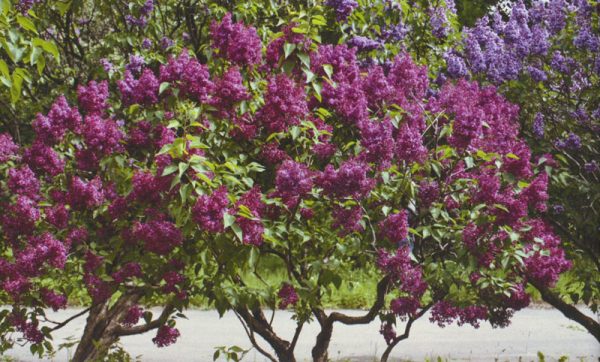
Monge
- Compact bush, up to 2 m high.
- Violet-red buds are beautifully combined with dark purple-red flowers of simple shape. The flowers are large, up to 3 cm, do not fade in the sun, bloom for a long time. The inflorescence is formed from 2-3 pairs of long panicles, 12 cm wide.
- The variety is abundantly flowering, frost-resistant.
Captain Baltet

Captain Baltet
- Shrub with a spreading crown up to 1.5 m high.
- Purple-pink buds are replaced by delicate lilac-pink flowers with gray-blue shadows. The flowers are simple, large in size (up to 3 cm), with bright yellow stamens. Inflorescences are large, formed from 1-3 pairs of sparse panicles, which cover the entire bush.
- Abundant flowering, in medium terms.
- Frost resistance is high.
Pink Perfume
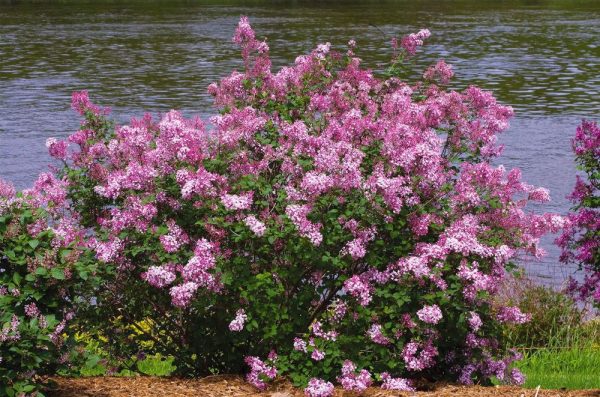
Pink Perfume
- Low shrub, 90 cm high, 120-180 cm wide.
- Dark pink buds favorably set off the lilac-pink flowers. Inflorescences up to 10 cm long, 7.5 cm wide, well suited for cutting.
- Frost-resistant variety.
Red Pixie
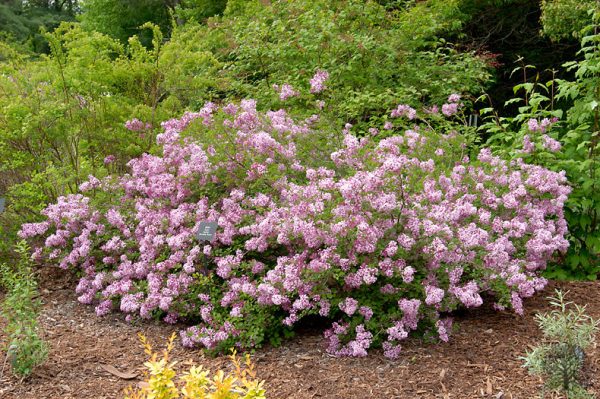
Red Pixie
- The bush is dense, compact up to 170 cm. In height and 120 cm.in diameter.
- The buds are purple-red. Large tubular flowers gradually change color from bright red to bright pink, then to light pink with a red border around the edges. Paniculate inflorescences 12-14 cm long.
- Abundant flowering in May-June, sometimes repeated in mid-August, for 20 days.
- Winter hardiness is high.
Schoolgirl

Schoolgirl
- A low-growing variety of lilacs up to 1.5 m in height and very spreading, its width can reach 2-2.5 m.
- Flowering in medium terms. Inflorescences are formed on the shoots, from 3-4 panicles, covered with large flowers up to 2.5 cm in diameter.
- Planting and caring for lilac bushes
- Japanese quince: planting, care, photo
- Privet shrub: how to plant and properly care
- Frost-resistant and beautiful shrubs for summer cottages
- Growing forsythia in the country, what varieties to choose for planting
- Choosing deren varieties for cultivation in the country
Peonies after flowering
ITO-peonies - unpretentious and exceptionally elegant hybrids of a favorite flower, bred not so long ago and rapidly conquered the market around the world, will become a real decoration of any garden. And for good reason - there are already hundreds of options for their sizes, shapes, colors and shades!
Of course, the once very rare yellow peonies are most in demand, but lovers of red, pink, white and even orange forms also have something to choose from ITO hybrids.
So, our TOP-9 ITO-hybrids (peonies).
Medium late flowering variety. American selection, originator - Andersen, 1999
Flowers are double or semi-double, large (about 15-20 cm in diameter), several delicate shades of pink-yellow with a dark orange-yellow spot in the center. The petals are slightly "crimped". Flowers bloom in turn. The aroma is very light. Flowering for 2-3 weeks.
Flowers stand well in cut.
The Canary Brilliants flower is an Ito hybrid that is semi-double or double-flowered. This variety was bred by breeders thanks to the crossing of two types of peonies: herbaceous and tree-like.
Peony Canary Diamond
The Canari peony is presented in the form of a bush of the Ito group, which consists of several strong stems and most often reaches a height of 90-100 cm.In the absence of thinning, the bush can branch strongly and reach a diameter of 80-90 cm.
On a note! The largest buds reach 20 cm in diameter. Slightly wavy petals at the beginning of flowering have a delicate color (creamy, pink, yellowish), but by the end of the period they darken.
Peony Itoh Canary Brilliants has a number of main advantages that cannot be ignored:
- Frost resistance. Mature plants with additional cover can withstand up to -25 ℃.
- Unusual coloration. In the spring, at the beginning of flowering, the buds have delicate soft shades, and by the end of summer they become more saturated and dark.
- Most hybrid peony varieties are characterized by large buds and a large number of flowers on the bushes.
- Well taken after breeding.
Of the shortcomings, only 2 factors can be named:
- They react poorly to heat. If summer in the region is accompanied by high temperatures (more than 25 ℃), then the bushes should be planted in semi-shaded places.
- Watering sensitivity. Waterlogging of the soil should not be allowed.
Peony Keneri Brilliant can successfully fit into any landscape design. You can use such a plant for several purposes:
Solo. On a green manicured lawn, peonies (one or more bushes) will look most impressive
In this case, nothing will distract attention from large double flowers.
In mixborders. Roses, clematis, phlox are suitable for peonies as neighbors
They are also planted alongside conifers such as small pines or junipers.
Peony Canary Diamond in landscape design
The flowering period of the plant is relatively long, while many large velvet buds appear on the bushes. To maintain the beauty of peonies, they need additional care during this time.
Young peony Brilliant in the first 1-2 years usually does not give flowers. If flowers appear, they are often irregular in shape. Cutting the buds helps to fix this. Starting from 3-4 years, the plant is considered an adult and blooms actively from the end of April or the beginning of May. The end of the flowering period is at the end of July.
Peonies bloom actively for a long time. The plant takes a lot of energy to do this. To constantly keep the flowers in good condition, you should be careful about regular watering and feeding.
It's important to know! The first fertilization is carried out already from the moment the buds appear.
Peony feeding
If the plant does not give flowers at 2-3 years of age, there may be several reasons:
- Lack of sunlight.
- Acidic soil. Lack of fertilizer. The plant simply does not have enough resources to form buds.
- Excess nitrogen fertilizers. With this top dressing, enhanced leaf formation occurs.
- Excess or lack of moisture.
Transfer
Repotting for the purpose of reproduction is recommended in the fall after the flowering period or in early spring. If the last option is chosen, then you can divide the bush until it has red shoots reaching a height of 15-20 cm.
If the bush needs to be transplanted to another place without dividing, this can be done in the summer.
Preparing for winter
In late autumn, the stems of flowers are cut, leaving columns no higher than 3-5 cm.In areas with cold winters peony Ito hybrid Canary Brilliant is covered with spruce branches or sawdust.
Additional Information! Plants should not be covered with foil for the winter. Due to the greenhouse effect, the rhizomes and aerial parts rot.
Top dressing
Light or dark purple peonies can be planted side by side. This creates an interesting decorative effect. They are also combined in bouquets. Sometimes white inflorescences are added to such buds.
In order for the flowers to be large and look spectacular on the bushes, a wedding bouquet, purple peonies need to be properly fed. In early spring, when the snow melts, the soil should be watered with a disinfectant near the bushes. To prepare it, take a bucket of water. Pour 2 g of potassium permanganate into it. One bucket is enough for disinfection around two bushes.
When the period of intensive growth begins, the peonies will need to be fed with ammonium nitrate. Dissolve 15 g of the product in a bucket of water. From mid-May, you need to water the peonies with mineral fertilizer. The dosage is chosen in accordance with the instructions of the manufacturer of the formulation. This feeding will need to be done once a month.
The nutrient solution can be supplemented with regular laundry detergent, which requires a tablespoon per bucket. By watering the leaves with such a composition, you can ensure that the bait will remain partially on them, and not completely drain into the ground. The procedure is performed in the evening or on a day when the sun does not shine brightly. Otherwise, the plant will get burned.
During the flowering and bud formation period, you will need to add a solution of ammonium nitrate (seven and a half grams), potassium salt (five grams) and superphosphate (ten grams). The listed substances are added to a bucket of water. Also during this period, you can alternately feed the peonies with organic and mineral fertilizers. They are brought into a previously prepared furrow around the bush. After that, the fertilizer is watered with water. The furrow is buried again.
When flowering is over, peonies only need timely watering. Once after the end of the flowering process, the soil will need to be loosened in time and fertilized. Weeds need to be removed.
Care Tips
All types of lilac and purple shades of peonies can be planted side by side, as well as create compositions from them by adding white buds.

In order for the flowers on the bush to be more lush, they need feeding, and it must be done correctly. Usually, top dressing is carried out in the spring - for this, the ground near the flower is watered with a special solution.The solution contains water and potassium permanganate, one bucket may be enough for several peony bushes. When the flower has grown, it should be treated with ammonium nitrate dissolved in water. Such feeding should be carried out once a month, the dosage is chosen according to the instructions of the composition. These actions are usually carried out in the evening hours, when the sun has already set, so as not to damage the plant. When the buds begin to pour on the peony, as well as during the flowering period, it is necessary to make a special composition with ammonium nitrate, potassium salt and superphosphate. Around the peony bush, a hole is pulled out and the resulting fertilizer is poured into it, after which the hole is covered with earth.


There are times when a plant planted in one place does not give buds - in this situation, it can be transplanted to a better place. If you need to propagate a plant bush, then it should be dug up and the roots should be divided into several parts. After that, you can plant the peony in another place. It is best if a flower is transplanted under the age of 4 years, previously bearing more than 2 times. This is because the older the peony, the thicker its rhizome, and it will be difficult to separate. Plant transplantation is best done in the autumn. If you transplant peonies in the spring, then they begin to hurt a lot and practically do not develop. When transplanting flowers in the spring, it is worth doing this after the ground has thawed.


What to consider when choosing a variety of peonies:
type - shrubs or herbaceous;
shape and color of the bud;
for what purposes - only for the season or as a perennial;
pay attention to the vitality of the plant;
plant size;
which stems are erect or hanging.
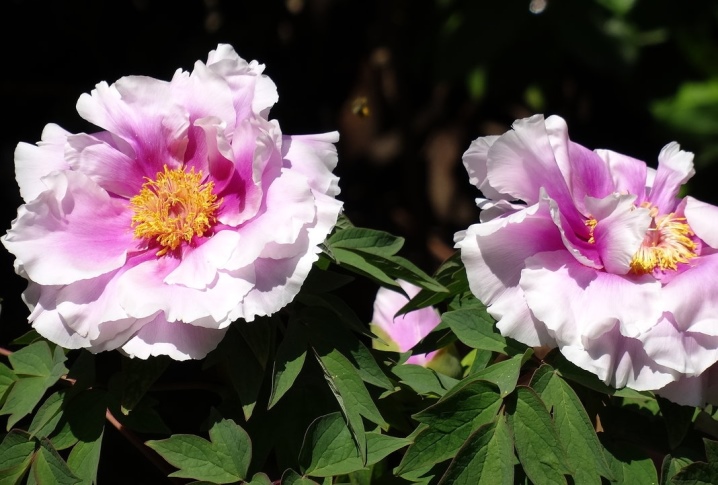
Do not forget about the peony flowering time. If you make the right selection and combine peonies, then they will bloom all summer. It must be remembered that shrub peonies will be the first to bloom. All this information can be found in the description of the peony variety:
- very early flowers;
- early buds;
- medium flowering;
- mid-late blooming;
- later and very late.
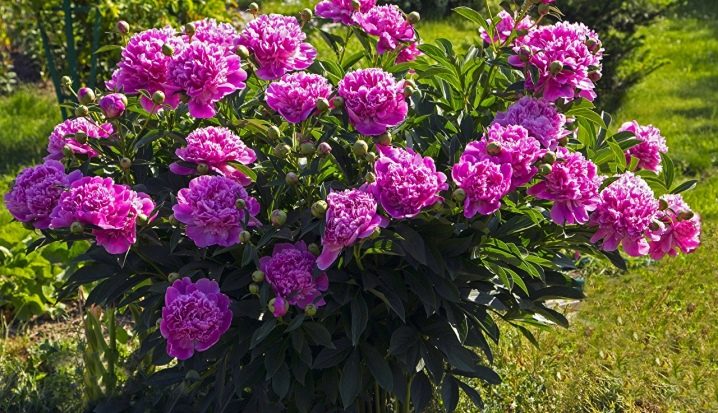
In herbaceous peonies, the stems extend directly from the roots - they will not harden, and in winter the entire ground part of the flower dies off.
Semi-shrubs have stems, woody only in the lower part, and at the top they are green, herbaceous, so only the herbaceous part dies off in winter. And in the spring, shoots from the woody part begin to grow.
More recently, breeders have bred another variety of peonies - these are mini-peonies, they are most often planted in containers. In height, such peonies reach only 60 cm, and their flowers are anemone-shaped. There is practically no information about them, and yet some types of such peonies even have their own names.
More information about a separate type of lilac peony is in the next video.
ITO-peonies: varieties
The hybrid group of peonies is a perennial with traits of herbaceous and tree-like plants. Varieties, in the selection of which the tree peony was the basis, bloom at an earlier date. Hybrids are characterized by variable color of petals. From tree-like peonies, about the features of which you can read here "Tree peony - the choice for a garden is obvious", they inherited the presence of bright spots or shading on flowers.
Lollipop is a great example. On a tall, spreading bush, variegated buds with a diameter of 17 cm appear. The shape is semi-double. The main color is yellow, with purple-violet strokes on the petals. During the flowering period, the background color changes, approaching peach and coral. At the same time, buds with different colors can be seen on the bushes. The size of the bush is 85-90 cm, the flowering period is average.
Information. ITO hybrids are the youngest varieties of peonies, the first were registered only in 1974.
Plants are endowed with the characteristics of two species forms, their stems die off with the arrival of the cold season and resume in spring. This is the main quality related to herbaceous peonies. Large, succulent, beautifully divided leaves, flower shape and woody roots are traits derived from arboreal ancestors.An interesting effect is provided by the proximity of bushes of various types. To decorate the landscape for many years, you can choose plants from the article “How to understand the variety of varieties of tree peony? ".
Popular varieties
Among the first registered ITO-hybrids were 4 yellow varieties, which are now widespread in landscape design:
Yellow Heaven (Yellow Haven) - semi-double yellow flower with a contrasting red spot at the base of the petal. On a compact bush, up to 50 buds bloom at the same time. Vanilla aroma.
Information. One of the main advantages of ITO hybrids is long flowering. It stretches up to three weeks.
Titled varieties include Bartzella and Garden Treasure. They became champions of the American Peony Society and were awarded gold medals.
- Bartzella is one of the most popular varieties with a record flowering period (up to four weeks). Giant yellow buds reach a diameter of 25 cm. The dense green leaves take on a bronze tint in autumn. You will find a description of the ornamental shrub with bright yellow flowers in the article "Peony" Bartzella "- bright and fresh like a lemon".
- Garden Treasure (Garden Treasure) - a tall perennial (80-90 cm) with strong, slightly deflected stems. The buds are semi-double, bright yellow, size 20-22 cm. A scarlet spot at the base of the petal adds attractiveness. The leaves are large, dark green, glossy. APS Gold Medal in 1996.
Ito hybrids come in various colors, rare varieties include:
- Dark Eyes is one of the darkest varieties of peonies. The color of the petals is a unique red-brown color. Stems are straight, strong, up to 90 cm. Flowers with an average diameter of 12-15 cm, semi-double. The open buds are shaped like a bowl with golden stamens.
- Joanna Marlen is a semi-double perennial of the American breeder Anderson. The bush grows up to 60-65 cm. The uniqueness of the hybrid is in the unusual color of the petals - the outer row is lavender or pink, closer to the middle - golden yellow. The size of the bud is 10-15 cm. When ripe, the shade changes. The cost of a rare variety is 8-12 thousand rubles.
Beautiful varieties with a description:
- Kellis Memory (Callies Memory) belongs to the group of hybrids with high spreading stems (90-100 cm). The flower is semi-double, multi-row. The outer petals are large. The color is creamy, with a hint of apricot; there is a pink edging around the perimeter of the petal. A cherry smear at the base. Kellis Memory has a pleasant aroma and is recommended for cutting.
- Pastel Splendor is a powerful shrub with large flowers with a persistent scent. The color is creamy, fading to light pink, with lavender shadows along the edge of the petals. In the middle of a simple flower, cherry-purple spots.
- Julia Rose is a sprawling decorative perennial that requires free space for growth. Buds with a diameter of 18 cm have a characteristic feature - their color changes from cherry to pink, then turns yellowish. On the bud, you can simultaneously observe changes in shades on different petals. The smell is very faint.
The article "Name of varieties of peonies with a photo or how not to get lost in the ocean of beauty?" Will help you to decide on the choice of flowers for your garden.
Red varieties
It is not for nothing that peonies are called the imperial flower, and specimens with red petals confirm this truth. Their spectacular appearance allows you to use flowers not only as a decoration for the site, but also in the form of bouquets.
The most popular varieties of this group are:
- Red Charm. A variety of herbaceous peonies characterized by semi-double flowers. The flower stalks, despite their height of 80 cm, are quite strong and stable, so the bush does not need a garter. The petals have a deep dark red hue.
- Moscow. Long flowering and pleasant aroma are the main advantages of the variety of domestic selection.Another advantage is its compact size (up to 55 cm in height), which makes it possible to grow it even in small garden plots. Cup-shaped buds are 10 cm in diameter, bloom in June and delight with paints for a month. The color of the petals is scarlet-red.
- Ruth Clay. The herbaceous variety belongs to the mid-flowering peonies. Bred by American breeders. The color of the petals of a 13-centimeter bud is rich red, almost burgundy. The flower has a pleasant, unobtrusive scent.
Types and varieties of peonies
According to the structure of the flower, peonies are divided into 7 groups:
Non-double
They have one or two rows of petals. The flowers are large, in the center of the flower there are numerous stamens, the leaves are sometimes corrugated (for example, the varieties Golden Glow, Nadia);
Semi-double
Very large light flowers, stamens are located either in the center of the flower, or between the petals. The flower usually has seven rows of petals. Varieties:
- Miss America - medium early variety, pink flower 25 cm in diameter turns white after opening, stamens are bright yellow;
- Ann Berry Cousins - an early variety of coral-pink color, a cupped flower 17 cm in diameter, a bush up to 65 cm in height;
In the photo: Non-double peonies
Japanese
The modified stamens in the center of the flower form a pompom; the petals in the flowers can be either in one or in several rows. Varieties:
- Carrara is a medium-flowering white variety, 16 cm in diameter, bush height - 80 cm;
- Hot Chocolet - mid-early maroon peony 16 cm in diameter; height - up to 80 cm;
Anemone
Transitional form from Japanese peonies to a group of terry peonies. The lower petals are wide, rounded, arranged in two rows; the central petals, shorter, form a ball. Varieties:
- Rhapsody - mid-early variety, marginal petals are pink, central, forming a ball - yellow-cream, flower diameter - 16 cm, bush height - 70 cm;
- Snow Mountain - an early cream-colored peony 17 cm in diameter, height - 75 cm;
Terry hemispherical, bomb-shaped, spherical
The petals of the flower are collected in a hemisphere, in full disclosure form a ball. Varieties:
- Pink Cameo is a medium late creamy pink 16 cm in diameter, bush 80 cm in height;
- Monsieur Jules Elie is an early fragrant variety of lilac-pink color, diameter - 20 cm, height - 90 cm;
In the photo: Semi-double peonies
Rosy
The petals of a flower, very similar in structure to a rose, are the same size, rounded, wide, large. Varieties:
- Solange is a late creamy white peony 17 cm in diameter, the height of heavy stems that need support reaches 70 cm;
- Henry Boxstock is an early variety of bright red color, 16 cm in diameter, a bush of 90 cm in height.
There is a subgroup of semi-pink peonies in the group of pink peonies, which differ in the presence of an islet of stamens in the middle of the flower. Varieties:
- Goody - mid-early, bright crimson, 16 cm across, height - 70 cm;
- Ballerina is an early variety of white-creamy-green color, a powerful bush, the diameter of the flowers is 18 cm.
Crown hemispherical and spherical
The flower petals are arranged in three tiers: the upper tier is a ring of petals, the middle one consists of petals narrower than those on the upper and lower tiers. As a rule, the top and bottom rows are the same color, the middle row may differ in color. Varieties:
- Nancy is an early peach-pink variety, 17 cm in diameter, a bush up to 80 cm in height;
- Aritina Nozen Gloria is a very early variety of pink-lilac shade, the height of the bush is 70 cm, the diameter of the flower is 20 cm.
Tree peonies: growing, pruning and wintering Peonies: planting, transplanting and reproduction
After this article, they usually read
Add a comment


